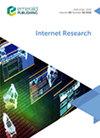你在撒谎!虚假信息指控是如何在Twitter上传播的
IF 5.9
3区 管理学
Q1 BUSINESS
引用次数: 0
摘要
众所周知,错误信息是很难对付的。尽管社交媒体公司一直致力于打击错误信息的发布,但错误信息传播的一个重要副产品——错误信息指控却被忽视了。作者对导致虚假信息指控在社交媒体平台上传播的因素提出了见解。设计/方法/方法作者使用关于2020年美国总统选举的234,556条推文(研究1)和关于2022年美国中期选举的99,032条推文(研究2)的语料库来展示如何通过运动方向来解释错误信息指控的共享。研究发现,作者较低的运动倾向解释了错误信息指控的分享,这种倾向在自由主义推文作者中被放大。从业人员和政策制定者可以通过开发算法来分析帖子的语言,利用研究结果来跟踪和减少错误信息指控的传播。这项研究的一个局限性是它关注的是政治错误信息指控。未来在不同背景下的研究,如疫苗,将是相关的。作者展示了社交媒体公司如何通过考虑推文作者的移动语言和地理数据来识别包含错误信息指控的信息,这些信息有可能成为病毒式传播。早期识别包含错误信息指控的信息有助于提高政治对话和选举决策的质量。社交媒体平台用于识别错误信息的独创性/价值策略缺乏规模且表现不佳,因此社交媒体平台管理错误信息指控以保持信任非常重要。作者确定了推动错误信息指控转发的语言和地理因素。本文章由计算机程序翻译,如有差异,请以英文原文为准。
You are lying! How misinformation accusations spread on Twitter
Purpose Misinformation is notoriously difficult to combat. Although social media firms have focused on combating the publication of misinformation, misinformation accusations, an important by-product of the spread of misinformation, have been neglected. The authors offer insights into factors contributing to the spread of misinformation accusations on social media platforms. Design/methodology/approach The authors use a corpus of 234,556 tweets about the 2020 US presidential election (Study 1) and 99,032 tweets about the 2022 US midterm elections (Study 2) to show how the sharing of misinformation accusations is explained by locomotion orientation. Findings The study findings indicate that the sharing of misinformation accusations is explained by writers' lower locomotion orientation, which is amplified among liberal tweet writers. Research limitations/implications Practitioners and policymakers can use the study findings to track and reduce the spread of misinformation accusations by developing algorithms to analyze the language of posts. A limitation of this research is that it focuses on political misinformation accusations. Future research in different contexts, such as vaccines, would be pertinent. Practical implications The authors show how social media firms can identify messages containing misinformation accusations with the potential to become viral by considering the tweet writer's locomotion language and geographical data. Social implications Early identification of messages containing misinformation accusations can help to improve the quality of the political conversation and electoral decision-making. Originality/value Strategies used by social media platforms to identify misinformation lack scale and perform poorly, making it important for social media platforms to manage misinformation accusations in an effort to retain trust. The authors identify linguistic and geographical factors that drive misinformation accusation retweets.
求助全文
通过发布文献求助,成功后即可免费获取论文全文。
去求助
来源期刊

Internet Research
工程技术-电信学
CiteScore
11.20
自引率
10.20%
发文量
85
审稿时长
>12 weeks
期刊介绍:
This wide-ranging interdisciplinary journal looks at the social, ethical, economic and political implications of the internet. Recent issues have focused on online and mobile gaming, the sharing economy, and the dark side of social media.
 求助内容:
求助内容: 应助结果提醒方式:
应助结果提醒方式:


